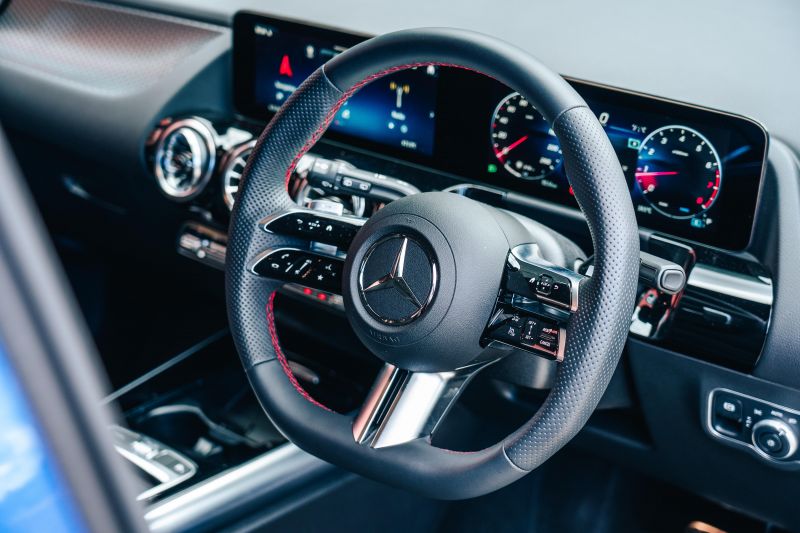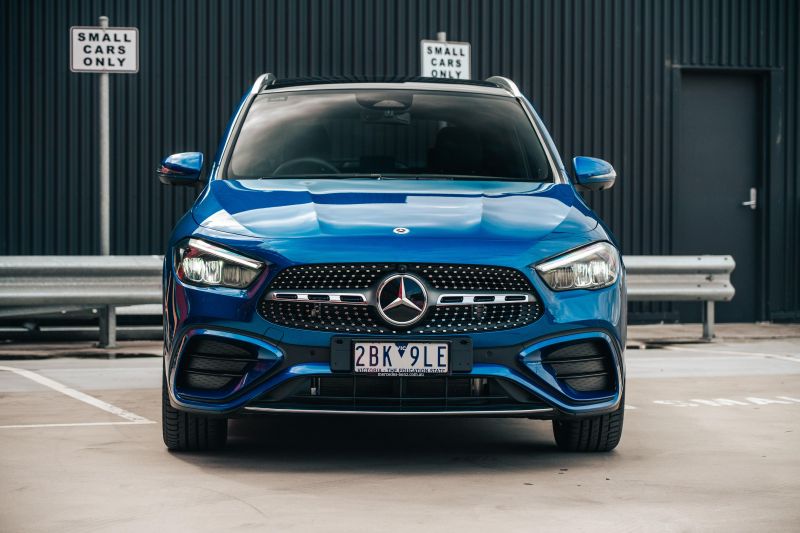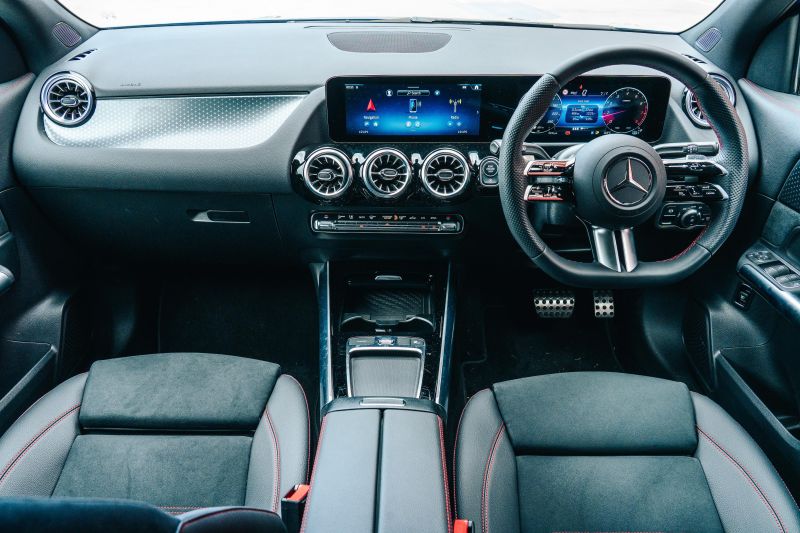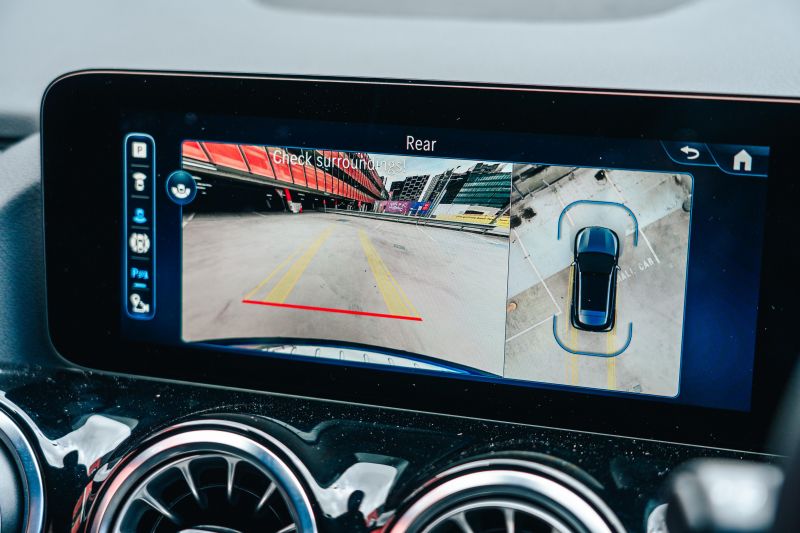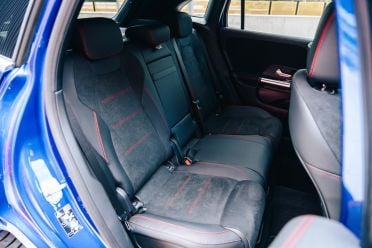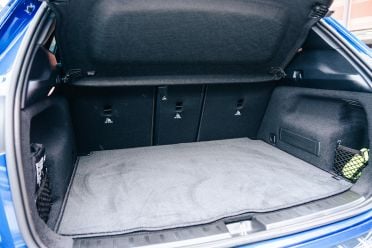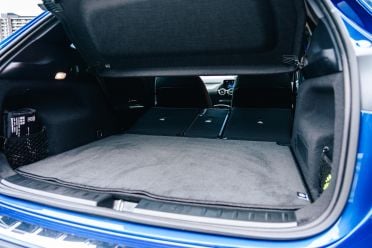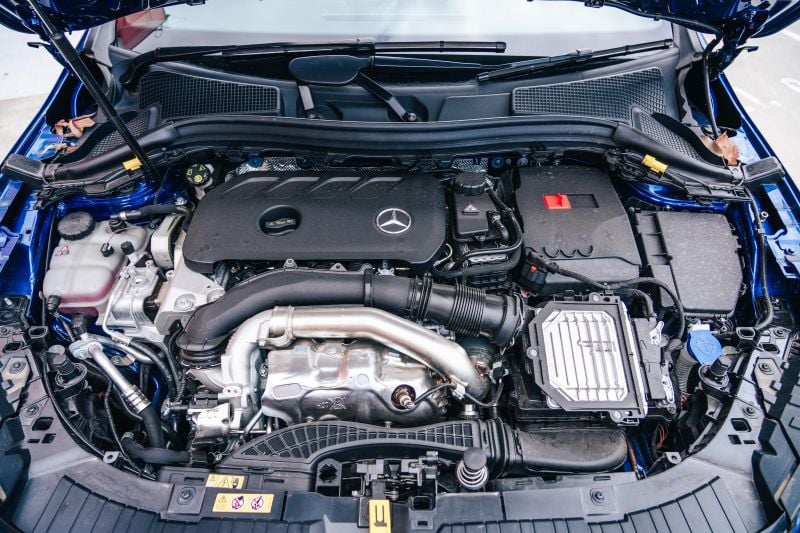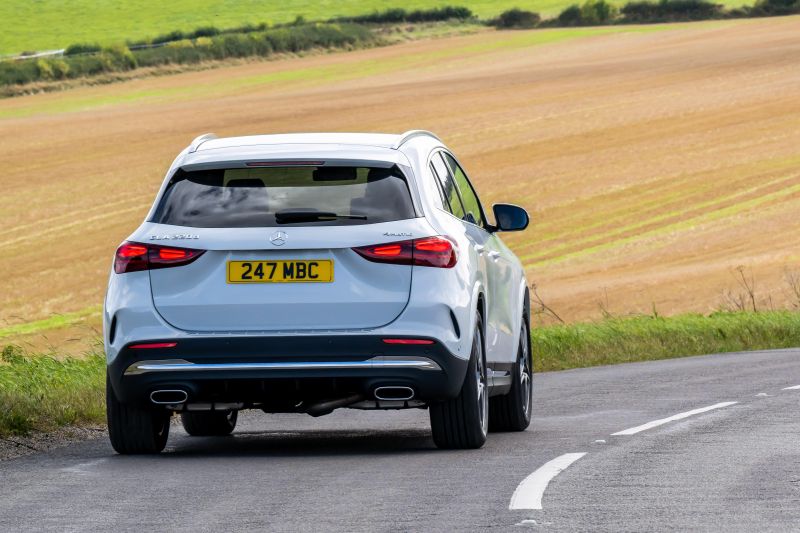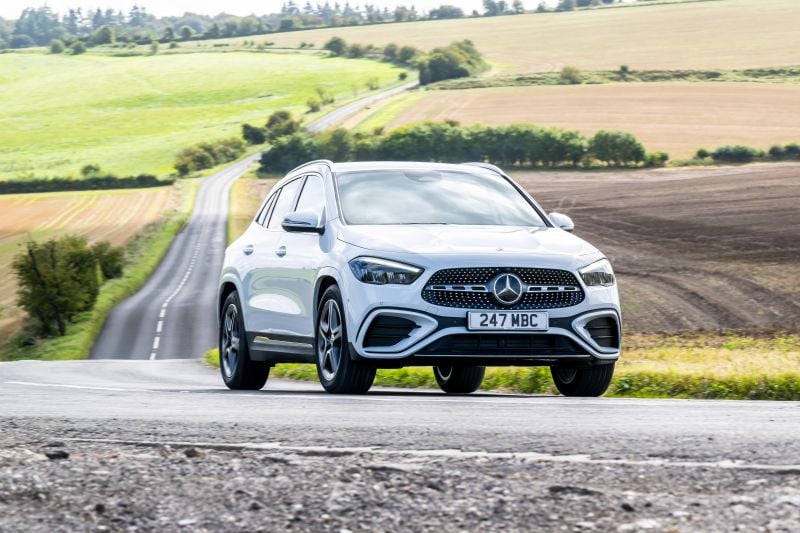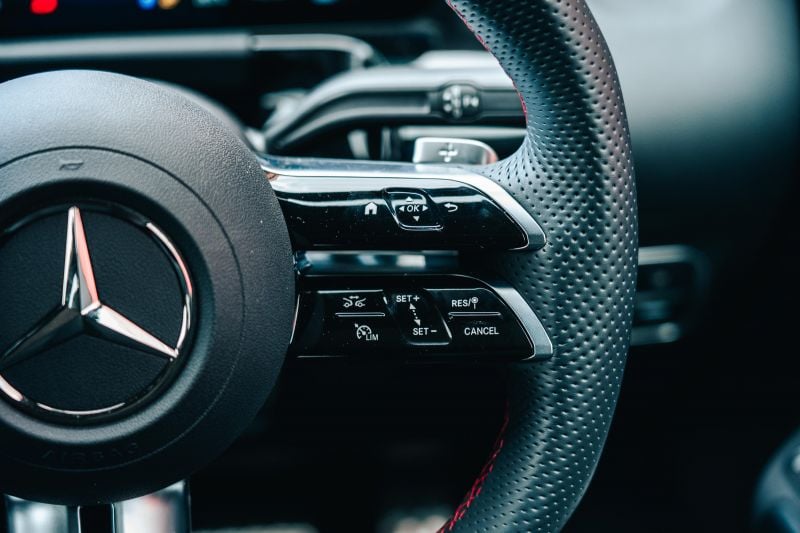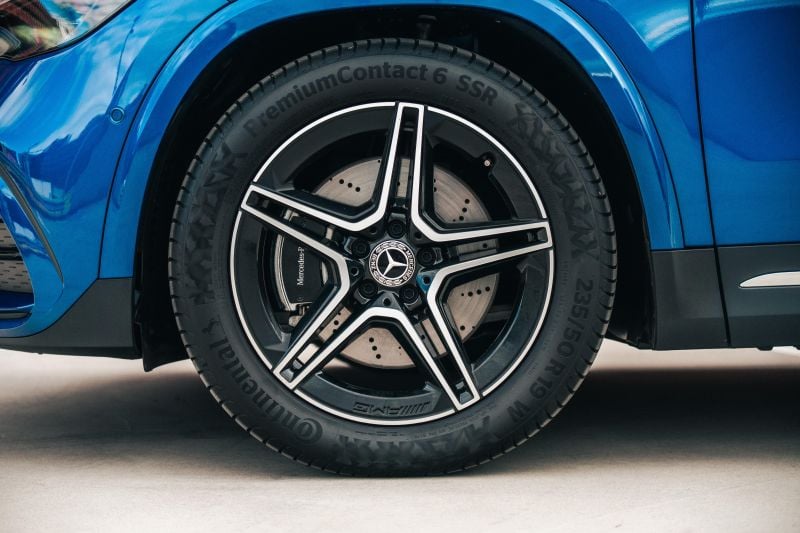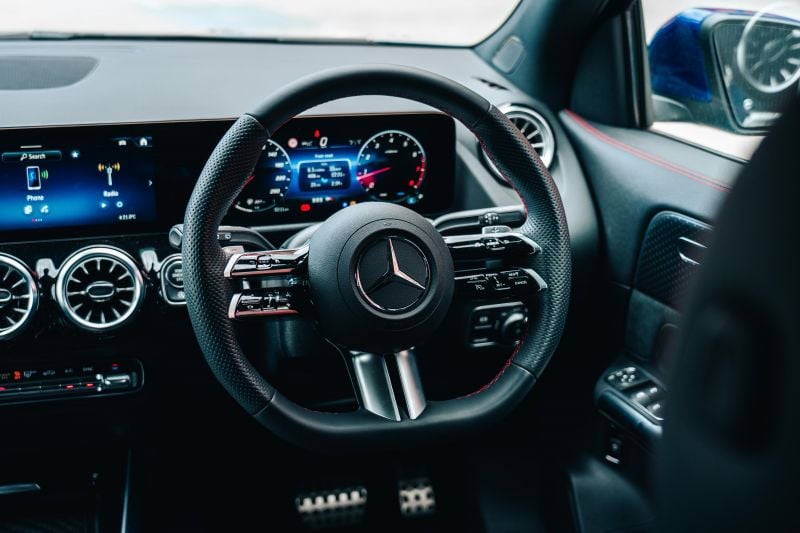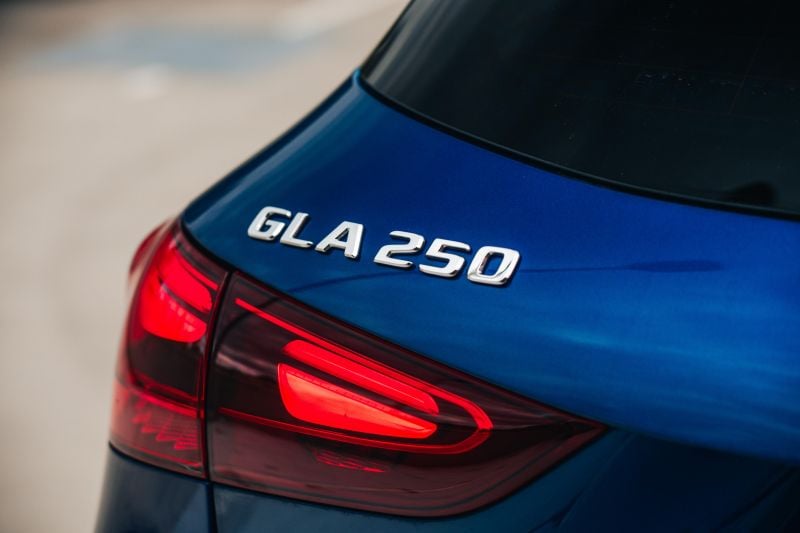The Mercedes-Benz GLA has formed the entry point to the German luxury carmaker’s SUV lineup for years now.
A formidable rival to the likes of the Audi Q3, BMW X1, Lexus UX, Mini Countryman, and Volvo XC40, among others, this small premium SUV has been on sale in Australia in second-generation guise since 2020.
Now it has received a worthwhile mid-life facelift.
On the outside there is a “modernised” headlight and tail-light signature, as well as a redesigned front bumper and grille.
Inside, there is a new steering wheel with touch-sensitive buttons and sliders, plus wireless Apple CarPlay and Android Auto connectivity, illuminated USB ports, and an additional USB-C port.
Under the bonnet, the mid-spec 2025 Mercedes-Benz GLA250 4Matic on test here, as well as the hotter AMG GLA35 4Matic, now get 48V mild-hybrid assistance, comprising a belt-driven starter-generator that’s capable of providing an additional 10kW for brief periods.
Is this small luxury SUV from the three-pointed star still the benchmark in its segment? Read along to find out.
How does the Mercedes-Benz GLA-Class compare?
View a detailed breakdown of the Mercedes-Benz GLA-Class against similarly sized vehicles.

Mercedes-Benz
GLA
How much does the Mercedes-Benz GLA cost?
On test here is the mid-range GLA250 4Matic, priced from a cool $80,500 plus on-road costs.
| Model | Price before on-road costs |
|---|---|
| Mercedes-Benz GLA200 | $63,600 |
| Mercedes-Benz GLA250 4Matic | $80,500 |
| Mercedes-AMG GLA35 4Matic | $99,000 |
To see how the Mercedes-Benz GLA lines up against the competition, check out our comparison tool
What is the Mercedes-Benz GLA like on the inside?
Despite its more compact dimensions, the Mercedes-Benz GLA feels very much like any other model from the German luxury brand. The door handles require a similar amount of force to open, and the doors make a familiar thwack sound when closed.
Once you’re in there are rather comfortable sport seats that feature plenty of electric adjustment and manually extendable thigh support. This means people of all different sizes and statures will be able to find their desired seating position easily.
As standard, the GLA gets microfibre upholstery with Artico artificial leather on the seat bolsters. While real leather is available as an option, I prefer this because it doesn’t make you feel as sweaty on hotter days.
Both front seats are heated, which was appreciated as it’s starting to get a little cooler here in Melbourne. On the highest setting, these seats got hot really quickly, which is yet another benefit of the microfibre upholstery.
Ahead of the driver is an AMG Line steering wheel, which feels chunky and is wrapped in soft Nappa leather. Annoyingly, it has touch-sensitive buttons and sliders for adjusting things like the sound system volume and cruise control, among other things, and they aren’t nearly as intuitive as proper physical buttons.
Another disappointing aspect of these buttons is the fact they are covered in glossy piano black panels which attract fingerprints and look grubby quickly.
While there are dedicated buttons for picking up and hanging up phone calls, there’s also no proper way to change the track that’s playing, which resulted in me having to use the touchscreen instead. Bizarre…
Behind the steering wheel is the same dual 10.25-inch screen setup that this car has featured for years now. It just has a refreshed look with the mid-life update.
The 10.25-inch digital instrument cluster looks crisp and high-resolution. It has a number of different layouts to choose from, and you can customise them to show different information. The Germans still know how to do a good instrument cluster.
Moving across, the 10.25-inch infotainment touchscreen still looks good, but compared to some rivals it’s starting to look a little small. The screen is very responsive to touch inputs and the user interface is dead easy to navigate.
Compared to the pre-update model, the GLA range now gets wireless Apple CarPlay and Android Auto. The window for smartphone mirroring also now takes up the entirety of the display, which looks much better.
Looking around the cabin, you can tell this car has received some tweaks over the years. The most notable is the removal of the touchpad on the centre console. Instead, there’s now an awkward storage space that isn’t big enough for a plus-sized phone.
I appreciate all the physical switchgear for the climate controls as they feel premium and are much more intuitive than having to use the touchscreen. It is somewhat annoying, however, that you need to look at the touchscreen to see what temperature you’re setting the system to.
While the majority of the finishes in this car look and feel premium to interact with, there’s an overload of glossy piano black around the cabin. It’s especially frustrating around the circular air vents because it attracts dust quickly.
There are a lot of darker finishes up front, though there is interior ambient lighting in certain areas, which makes the car feel a bit more special at night. There’s also a panoramic glass sunroof as standard, which has a panel that tilts and slides to offer more air flow.
Moving to the second row, it’s clear there’s more emphasis put on the seats up front. It’s not a terrible space to be, it just doesn’t feel as special.
At a leggy 182cm, I had enough leg, head, shoulder and toe room behind by own driving position. Two adults will fit fine in the second row, though pushing it to three would make things squishy. The person in the middle seat also has to contend with the sizeable transmission hump.
Second-row amenities include air vents, USB-C ports, as well as a fold-down armrest with retractable cupholders. It’s pretty standard.
Around the back, there’s a power tailgate that has a hands-free function, which comes in handy if you’ve got your hands full of stuff. With the tailgate open, there’s a decent amount of boot space, though it won’t blow you away.
Disappointingly, there’s no spare wheel here. As standard, the car comes with run-flat tyres, though you can opt for a tyre repair kit as a no-cost option. This isn’t ideal for those who frequently travel in the country.
| Dimensions | Mercedes-Benz GLA250 4Matic |
|---|---|
| Length | 4443mm |
| Width | 1849mm |
| Height | 1584mm |
| Wheelbase | 2729mm |
| Cargo capacity | 425L (5 seats) 1420L (2 seats) |
To see how the Mercedes-Benz GLA lines up against the competition, check out our comparison tool
What’s under the bonnet?
The Mercedes-Benz GLA250 4Matic’s 2.0-litre four-cylinder turbocharged petrol engine gains 48V mild-hybrid assistance with the mid-life facelift.
| Specifications | Mercedes-Benz GLA250 4Matic |
|---|---|
| Engine | 2.0L 4cyl turbo-petrol 48V MHEV |
| Power | 165kW |
| Torque | 350Nm |
| Transmission | 8-speed DCT |
| Drive type | AWD |
| Weight (tare) | 1724kg |
| Fuel economy (claimed) | 7.9L/100km |
| Fuel economy (as tested) | 8.2L/100km (400km) |
| Fuel tank capacity | 51L |
| Fuel requirement | 95 octane premium unleaded |
| CO2 emissions | 178g/km |
| Emissions standard | Euro 6 |
To see how the Mercedes-Benz GLA lines up against the competition, check out our comparison tool
How does the Mercedes-Benz GLA drive?
Starting up the GLA250 4Matic, the turbo-petrol engine deliver a rowdy rev flare, which is more noticeable in the cabin than outside the car. Tat’s because this car pumps fake engine sound into the cabin.
-
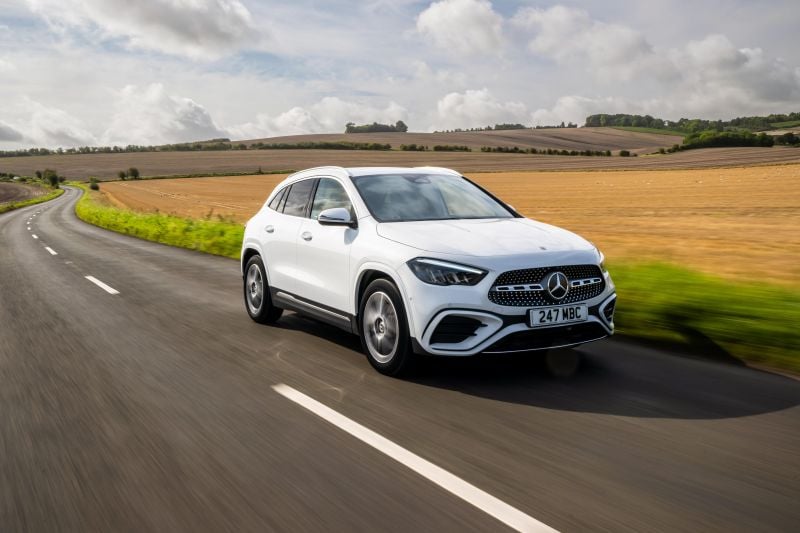
GLA220d – Overseas model shown
To set off, you use the column-mounted gear selector, which feels premium and sleek. It’s handy because you can quickly flick from drive to reverse, especially in parking scenarios or when doing a three-point turn.
When the engine is still warming up, the first two gears rev out to around 3000rpm, which feels like way too much. This creates a jarring feeling inside the cabin, as the engine doesn’t sound the best at these revs.
Once the engine has warmed up a little, or you start travelling a bit faster, the car then opts for higher gears and will keep the revs down to minimise fuel consumption. This feels a lot more natural and calm.
While the 2.0-litre turbo four in this car is far from new, it is now augmented with mild-hybrid assistance, which allows for more seamless and longer engine idle stop/start interaction. When in Eco mode, the car can also coast with the engine switched off to save fuel.
As part of this 48V system, there’s a belt-driven motor generator that is used to start the engine, but can also provide an additional 10kW of power for brief periods. This helps for faster acceleration, or to generally take load off the engine.
Another part of the 48V mild-hybrid system is the regenerative braking system, which helps top up the small 48V battery pack. It’s satisfying to know that you’re recuperating energy to then use to help performance later on.
In practice, the system is seamless and even has an intelligent function by which it’ll increase the amount of regenerative braking based on how quickly the car in front of you is travelling. It means you don’t have to think that much about it and can instead focus on driving.
As a package, this powertrain is a little firecracker. You’ll easily be keeping up with traffic from the lights, and with only a subtle flex of your right foot, you’ll be accelerating faster than most. At no point was I looking for more power, which makes me feel like the AMG GLA35 is somewhat superfluous, as many performance cars are.
This car comes with an eight-speed dual-clutch automatic transmission, which provides snappy and almost instantaneous gear changes. With the assistance of the 48V motor generator, a lot of the dual-clutch hesitancies are ironed out, making it feel more seamless behind the wheel.
However, there were still moments where it was abundantly clear this car has a dual-clutch auto. An example included when I changed from drive to reverse on a hill and started to roll before the gear actually engaged. This wasn’t the most confidence-inspiring feeling behind the wheel.
While the engine packs a punch, it also has the driving dynamics to match. The steering is wonderfully direct and well-weighted for tossing this small SUV around on city streets. It’s rather smile-inducing.
Even though all local non-AMG GLAs come with the AMG Line package as standard, they don’t actually have sport suspension. Instead, they have a lowered version of the comfort suspension, which is great because this means the car doesn’t feel overly stiff all the time.
This car soaks up general lumps and bumps that occur with general urban road imperfections without any worries, though harsher singular bumps can send shocks into the cabin. It feels a little brittle if you hit a hard bump with a little too much pace.
On the parking front, there are front and rear parking sensors, as well as a surround-view camera which has great quality. There’s also a parking assistant, which is handy if you’re not the most confident at parallel or perpendicular parking, though it’s slow.
Out on the open road, this car settles into a perfectly comfortable cruise. The engine revs are kept down low as the transmission prioritises the highest gear possible, though there is a bit of tyre roar at higher speeds. This isn’t uncommon with European cars, especially those with run-flat tyres.
There’s still plenty of punch available if you need to do a quick overtake. The transmission will drop a few gears and the 48V motor generator will help get acceleration happening as soon as possible. You need to keep an eye on your speed because you’ll easily creep above the speed limit if you’re not paying attention.
The steering still feels incredibly direct and well-weighted, which makes this fun to drive in the twisties. Like many crossover SUVs, however, the GLA does get a bit of body roll up when pushed. It’s not horrible, but it limits its dynamism compared to a lower-slung hatchback, for example.
Like at lower speeds, the suspension feels settled and composed at higher speeds, though harsher bumps can transmit into the cabin.
On the safety front, the GLA is now fully loaded. With the mid-life update, it now gets adaptive cruise control as standard. It’s an intuitive system which is able to keep a safe distance between the car ahead and not freak out when a car cuts in front of you.
The lane-keep assist is fairly relaxed with how it reacts when you get close to the lane markings but, disappointingly, there’s no active lane-centring function as standard. You need to opt for the Plus Package to get this, among a range of other features, including a head-up display and adaptive high-beam.
To see how the Mercedes-Benz GLA lines up against the competition, check out our comparison tool
What do you get?
On test here is the mid-spec Mercedes-Benz GLA250 4Matic with no option packages.
2025 Mercedes-Benz GLA200 equipment highlights:
- LED headlights with adaptive high-beam
- Power-adjustable front sports seats
- incl. memory function
- incl. 4-way lumbar
- Heated front seats
- Galvanised paddle shifters
- AMG Line exterior package
- 10.25-inch digital instrument cluster
- 10.25-inch touchscreen infotainment system
- Apple CarPlay, Android Auto – wireless
- Satellite navigation with live traffic
- Wireless phone charger
- Nappa leather-wrapped steering wheel
- Semi-autonomous parking assist
- Panoramic sunroof
- Dual-zone climate control
- Keyless entry and start
- Power tailgate
GLA250 4Matic adds:
- Off-Road Engineering Package
Options
The GLA250 4Matic is available with a number of different options, but none were equipped to our tester.
Plus Package: $5000
- Driving Assistance Package
- Augmented reality satellite navigation
- Burmester sound system
- Illuminated door sills
- Head-up display
- Multi-beam LED headlights
- Adaptive high-beam
- MBUX Interior Assist
- Surround lighting with projected logos
Other standalone options include:
- 20-inch AMG multi-spoke black alloy wheels: $1600
- Black Lugano leather upholstery: $1700
To see how the Mercedes-Benz GLA lines up against the competition, check out our comparison tool
Is the Mercedes-Benz GLA safe?
The Mercedes-Benz GLA has a five-star ANCAP safety rating based on tests conducted on the related B-Class in 2019.
-

B-Class
| Category | Mercedes-Benz GLA |
|---|---|
| Adult occupant protection | 96 per cent |
| Child occupant protection | 92 per cent |
| Vulnerable road user protection | 79 per cent |
| Safety assist | 77 per cent |
Standard safety equipment includes:
- Autonomous emergency braking
- Adaptive cruise control
- Blind-spot monitoring
- Lane-keep assist
- Safe exit warning
- Traffic sign recognition
- Surround-view camera
- 9 airbags (front, side and curtain, plus a driver’s knee airbag)
Opting for the Plus Package on the GLA200 and GLA250 4Matic adds:
- Active Distance Assist
- Steering Assist
- Active Lane Change Assist
- Extended route-based speed limit assist
To see how the Mercedes-Benz GLA lines up against the competition, check out our comparison tool
How much does the Mercedes-Benz GLA cost to run?
The Mercedes-Benz GLA is covered by a five-year, unlimited-kilometre warranty.
| Servicing and Warranty | Mercedes-Benz GLA |
|---|---|
| Warranty | 5 years, unlimited kilometres |
| Roadside assistance | 5 years |
| Service intervals | 12 months or 25,000km |
| Pre-paid service plans | $3495 (3 years) $4650 (4 years) $6185 (5 years) |
To see how the Mercedes-Benz GLA lines up against the competition, check out our comparison tool
CarExpert’s Take on the Mercedes-Benz GLA
The Mercedes-Benz GLA has long been a default option for those looking at a small but luxurious SUV.
There are now more rivals than ever, but this car still shines through as a benchmark, though it’s starting to feel its age.
This mid-life update has invigorated the GLA just enough, though there are newer rivals like the BMW X1 that offer more technology and much better value.
It’s nice there is now wireless smartphone mirroring, as well as different looks inside and out to keep things fresh. Some of the changes hinder the useability, though, including the fiddly touch sliders on the new steering wheel. The storage space where the touchpad used to be also just looks weird.
I’m a fan of the new 48V mild-hybrid version of the 2.0-litre turbo-petrol engine in this GLA250 4Matic.
It certainly packs a punch and you likely won’t be looking for any more power in your everyday commute. However, it doesn’t notably improve fuel consumption.
Lastly, let’s talk money. The GLA is certainly one expensive small SUV. At $80,500 before on-roads for the GLA250 4Matic on test here, it’s considerably more expensive than all of its direct rivals. It’s also rather expensive to service, which is a further pain point.
If you’re willing to buck up the cash for one of these and are a die-hard fan of the three-pointed star, you’ll love this car as a package. It certainly doesn’t disappoint.
If you’re more brand-averse, however, it may be worth checking out the competition because there’s plenty out there.
Interested in buying a Mercedes-Benz GLA? Get in touch with one of CarExpert’s trusted dealers here
Click the images for the full gallery
MORE: Everything Mercedes-Benz GLA



